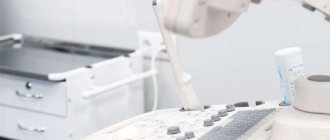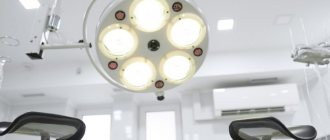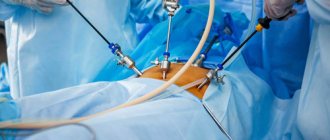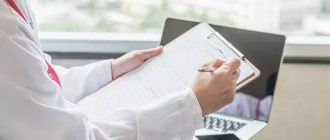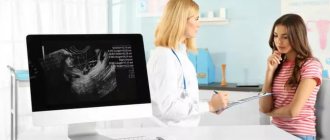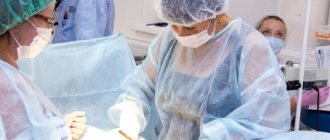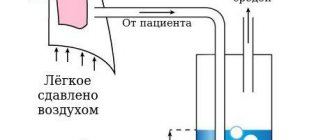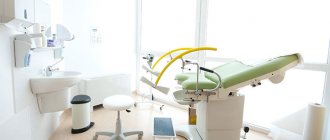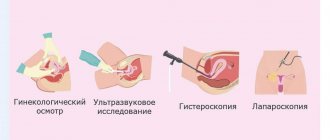Laparoscopy is an operation whose purpose is to diagnose a disease or surgically treat it. The main distinguishing feature of the laparoscopic method is minimal damage to external tissues. Manipulations on organs are performed through small incisions, and control is carried out using a laparoscope equipped with a tiny video camera.
The operating surgeon evaluates in detail the image of the internal organs displayed on the monitor. Despite the minimally invasive method, it belongs to surgical interventions. Therefore, preliminary preparation, diet and rules of nutrition after laparoscopy must be strictly observed. Features of the postoperative diet depend on the area of the body where laparoscopy was performed.
About intervention
Progressive surgical techniques are used for examination and operations on the abdominal organs, female internal genital organs (in gynecology), and in the field of thoracic surgery (diagnosis and operations on the chest organs). The most widely used types of laparoscopic interventions are:
- excision of the gallbladder (cholecystectomy);
- removal of appendicitis (appendectomy);
- resection of the stomach or its (gastrectomy);
- laparoscopic operations on the ureter and bladder;
- fragmentary excision of the pancreas, duodenum (Whipple operation or pancreaticoduodenectomy)
- resection of a fragment of the small and large intestine;
- laparoscopy of the lung.
In gynecology, similar operations are performed to remove ovarian cysts, in case of pathology of the fallopian tubes and uterus. All types of operations are performed after a thorough examination, including: laboratory blood tests (clinical and biochemical), hardware diagnostics (ultrasound, magnetic resonance and computed tomography, x-ray examination).
The patient must follow a diet and, in some cases, take certain medications, which the doctor will tell you about.
Certain rules are provided for in the period after surgery, most of them relate to diet and physical activity. Compliance with the conditions helps to quickly restore body functions after surgery.
Benefits of laparoscopy
You should be aware of the advantages of laparoscopic intervention over abdominal surgery. Firstly, this is a short rehabilitation period. Recovery will take only 3 to 5 days (the woman will be in the hospital during this time). If you cut the abdominal wall with a scalpel, you will have to stay in the hospital for at least 10, maximum 15 or more days.
As for the type of stitches that remain after the operation, after laparoscopy there will be three small scars, each of which is a maximum of one and a half centimeters. They won't be noticeable.
Endoscopic operations give the surgeon the opportunity to fully control the process through the control of a video camera. It displays the image on the screen at 10x magnification. This operation is gentle because, due to video control, the doctor has no chance of damaging healthy tissue.
The need for a dietary diet in the postoperative period
First of all, proper nutrition requires an optimal balance of nutrients (fats, carbohydrates, proteins). This, in turn, ensures the normal functioning of the gastrointestinal tract. The patient does not experience dyspepsia (difficult and painful digestion) or flatulence. There are no problems with bowel movements (diarrhea, constipation).
The postoperative diet consists of so-called healthy foods. The use of which helps strengthen the immune forces of a weakened body. The sutures, even small ones, are tightened faster, and the risk of adverse postoperative complications is extremely limited. In addition, such products accelerate the elimination of toxic substances accumulated under the influence of anesthesia, facilitating the functioning of the liver.
The diet promotes the regeneration of the body's hormonal and reproductive systems. Especially in cases where laparoscopic surgery in the field of gynecology was performed. If you have difficulty creating a menu on your own, you should seek help from a nutritionist.
General conditions for proper nutrition
The diet after laparoscopic surgery takes into account the chemical composition and physical properties of the products, as well as the culinary method of processing the dishes and the time interval between meals.
Why does it hurt after laparoscopy?
Key points for healthy post-operative nutrition:
- The initial meal after laparoscopic surgery must be agreed with the doctor. If nausea from anesthesia is not present, chicken broth is allowed after six hours (fat skin is removed from the bird before cooking);
- food should be warm, but in no case hot. Aggressive effects of high temperatures on the digestive system are not allowed;
- The interval between meals is determined by two and a half hours. The serving size is no more than 300 grams; it is unacceptable to be greedy in food;
- preference is given to products enriched with minerals and vitamins, without disturbing the balance of nutrients;
- herbal infusions are welcome;
- culinary processing of products by frying is excluded. You can only eat dishes that are prepared by stewing, boiling, or baking without oil (other fat);
- In the first post-operative days, the best option would be to grind food with a blender to a puree state. In this form, food will be easier to digest;
- The diet should not change in a forced mode. Products are introduced in stages, from light to more difficult to digest;
- At the stage of introducing fresh fruits and vegetables, you should not eat hard skins.
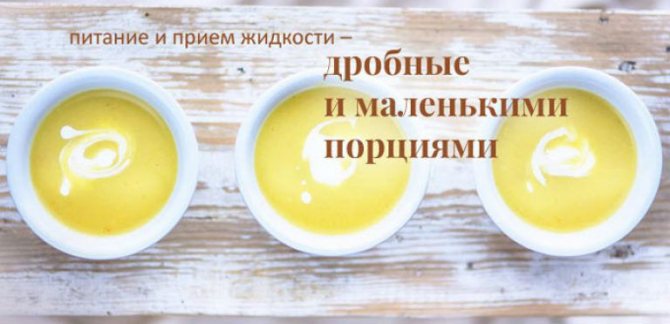
This advice is used in most cases where dietary adjustments are necessary.
The diet cannot be stopped after discharge from the hospital. Throughout the month, the risk of complications due to overeating or consumption of prohibited foods remains. There is a complete taboo on any alcohol during the postoperative period.
Products to be excluded from the diet
The average duration of the diet after laparoscopy is four weeks. Next, you can navigate according to your own well-being. What not to eat:
- animal fats: butter, lard and fresh lard;
- fish and meat prepared by hot or cold smoking;
- fatty mayonnaise-based sauces and ketchups;
- canned foods (fish, meat, vegetables);
- salted and pickled mushrooms and vegetables;
- whole grain baked goods, including bread;
- baked goods, sweet desserts;
- peas, chickpeas, beans, lentils;
- raw vegetables;
- strong fruits (pears, apples) and citrus fruits;
- carbonated drinks, yeast-containing kvass;
- nuts;
- fast food;
- seasonings, spices.
Sausages, fatty cottage cheese and milk, and dried fruits are subject to restrictions. A failure in diet can result in postoperative complications. In patients who ate prohibited foods, suture dehiscence was observed due to difficulty in bowel movement.

Products prohibited during the postoperative period
Diet after laparoscopy of an ovarian cyst: what to exclude from your menu
During the period of recovery of the body after laparoscopy of an ovarian cyst, women are strictly prohibited from consuming alcoholic beverages, coffee and various carbonated drinks. Instead, you should consume compotes, fruit drinks, herbal teas, and home-made juice.
Among other prohibited foods during the diet after laparoscopy of an ovarian cyst, the following should be listed:
- Fatty food;
- A variety of canned food, marinades, pickles, smoked meats;
- Hot spices, herbs, sauces and ketchups, mustard, seasonings;
- Raw fruits;
- Chicken eggs;
- Sweet products and baked goods: chocolate, cakes, custard pies, baked goods. Bread in small quantities is allowed to be consumed starting from the third day after surgery.
After laparoscopy, it is advisable to eat frequently and in small portions, that is, follow a balanced diet. The recommended frequency of meals is 6-8 times a day.
Yusupov Hospital is a European center that provides high-quality therapeutic and surgical care. The clinic performs operations in all areas of modern surgical gynecology. All patients who give preference to the Yusupov Clinic receive effective comprehensive treatment, consultation from many of the center’s leading specialists in various fields of medicine and, most importantly, highly qualified care. To make an appointment please call.
Recommended Foods
When correcting the diet, the main emphasis is on light foods rich in vitamins and microelements. What can you eat after laparoscopy: porridge with water or low-fat milk of a thin consistency, steamed, boiled or stewed vegetables: carrots, zucchini, beets, liquid mashed potatoes, broths and light vegetable soups, lean fish (pollock, haddock, hake), which are cooked by steam method.
The list continues with boiled turkey or chicken (steamed poultry cutlets), beef liver processed by stewing, soft cottage cheese, yogurt, fermented baked milk, kefir (the fat content of fermented milk products is maintained at 2.5%), fruit and oatmeal jelly. Also recommended are any seafood, peeled fruits, berries, omelettes cooked in the microwave, homemade compotes, and diluted freshly squeezed juices.
It is recommended not to add salt to cooked dishes. Ideally, exclude salt from the diet during the diet.
Additional recommendations
Nutrition after removal of appendicitis and gall bladder surgery requires special attention, since these organs are directly related to the digestive system. Daily diet after laparoscopy:
- first day. After recovery from anesthesia, only table water without gas is allowed in small portions. In the absence of a gag reflex and a feeling of nausea, after 6 hours you can drink weak chicken broth;
- second day. It is optimal to start your meal with low-fat yogurt (you can drink it). You can add vermicelli or noodles to the broth;
- the next 2–3 days involve the introduction of liquid mashed potatoes without oil, boiled fish, chopped boiled chicken in broth, porridge in water, soft cottage cheese, fruit puree;
- on days 4-5, the diet should be enriched with steamed or stewed vegetables. A little marshmallow and baked apples are allowed.
At the end of the week, the operated patient can switch to a full diet of foods from the recommended list of acceptable ones. To normalize the bowel movement process, boiled beets with prunes chopped in a blender are recommended for daily consumption. This salad should be topped with natural yogurt.
Recovery after laparoscopy
One of the advantages of laparoscopy and the advantage over abdominal surgery is the short postoperative period and rapid recovery. Sometimes the patient can go home almost immediately after laparoscopic surgery. But they talk about the postoperative period even in this case, since laparoscopy is a serious surgical intervention with general anesthesia and a recovery period.
Postoperative period - the patient’s condition after laparoscopy
The patient's condition in the postoperative period is usually satisfactory. Many negative consequences and complications can be avoided due to rapid recovery. As a rule, the patient is discharged on days 3-5, but this does not mean that he can immediately return to his previous rhythm of life. Moreover, in the postoperative period after laparoscopy there is still room for some complaints. Let's look at some of them.
Flatulence after laparoscopy
Abdominal bloating is common in the postoperative period. This is due to a certain laparoscopy technique - the introduction of gas into the abdominal cavity. As a rule, the doctor prescribes medications to combat flatulence. It is important to quickly establish intestinal function and not to forget about physical activity in the first days after surgery.
Nausea, lethargy in the postoperative period
After laparoscopy, the patient may complain of weakness, nausea, loss of appetite, sore throat when swallowing (consequence of insertion of an anesthesia tube). This is a completely normal reaction after surgery. Dyspepsia usually goes away without treatment after a couple of days.
Pain in the area of postoperative incisions.
Despite the fact that the incisions in the peritoneal area are miniature, they can be disturbing. The pain may worsen with any movement. This should not worry the patient as the healing process is ongoing. If the pain causes severe anxiety, you should tell your doctor. Most likely, he will prescribe pain medication.
Nagging pain in the abdominal area.
During laparoscopy on the pelvic organs, damage to nearby surfaces sometimes occurs. Drawing pain indicates the healing process and goes away after a few days. But if the pain in the abdominal area becomes unbearable, you should consult a doctor urgently to rule out a complication. If the pain is accompanied by fever, or heavy vaginal discharge appears, then you should also inform your doctor.
Nutrition during recovery after laparoscopy
Immediately after laparoscopy, and even better during the entire first postoperative day, it is better not to eat. You can drink (if there is no nausea) small sips of still water.
Nutrition for 2-3 days of the postoperative period
On the second and third days, doctors recommend introducing boiled or steamed dishes into the diet - lean meat, fish in the form of cutlets, meatballs. The diet may include kefir, low-fat cottage cheese, and buckwheat porridge. You need to eat 6-7 times a day in small portions.
What can you eat after laparoscopy?
By the end of the week, nutrition after laparoscopy will be without restrictions (if the postoperative period passes without complications). You should talk more fully about diet and nutrition during the recovery period with the operating doctor. The main principles of nutrition after laparoscopy are to eat often, not to overeat, portions should be small, exclude salty, spicy, fried and alcohol. It is important to monitor bowel regularity.
Recovery after laparoscopy - questions and answers.
The most popular questions asked by patients after laparoscopy.
1. When can you get up after laparoscopy?
As a rule, the patient can get up 3-4 hours after surgery. You need to get up carefully, preferably with outside help, listening to your body. The distances should be short on the first day - to the toilet and back. The next day, physical activity expands. The patient can independently reach not only the toilet, but also walk along the corridor. By the way, walking quickly normalizes intestinal function and reduces flatulence.
2. When can I exercise after laparoscopy?
Physical stress after laparoscopy should be avoided for two to three weeks. In the future, you can introduce sports, but do it gradually. No heavy lifting for 3 months.
3. Will scars be noticeable after laparoscopy?
Incisions made during laparoscopy heal quickly. On the second day, the surgeon examines the sutures, and after 1-2 weeks the sutures are removed (usually on the 7th day). How visible the scars will be depends on the patient’s body, individual skin properties and immunity. Usually after a few months they fade and no traces of the incisions remain. But sometimes purple scars remain at the site of the incisions, although this happens extremely rarely.
4. When is sex possible after laparoscopy?
If laparoscopy was performed due to a gynecological disease, the doctor will answer this question. In any other case, sex is possible 14-20 days after surgery.
5. When can you plan a pregnancy after laparoscopy?
If the operation was not related to gynecological surgery, then there are no restrictions on conception. But many doctors advise that a month or two pass (the body must fully recover from anesthesia). After successful gynecological laparoscopy, pregnancy can be planned within a few months after consultation with the attending gynecologist. So, for example, if there was a laparoscopy to remove uterine fibroids, then pregnancy can be planned in six months, and if adhesions formed due to inflammation of the appendages were removed, then pregnancy is possible 1-2 months after the operation.
6. When can you wash after laparoscopy?
The shower can be used immediately after discharge. Doctors do not recommend taking a bath during the first month. The swimming pool, bathhouse, sauna, hammam cannot be visited for 30-60 days (depending on the speed of healing of the incisions)
Recommendations – what not to do after laparoscopy.
It is forbidden!
- eat food in the first 24 hours after surgery,
- lift weights and reach with your arms up (hanging laundry) for 90 days,
- drink alcohol during the first 30 days (risk of bleeding),
If you are responsible and follow all the recommendations and advice, the postoperative period will pass without complications, and the recovery process after laparoscopy will be easy and quick.
